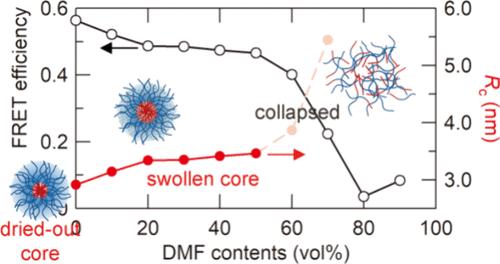关于聚苯乙烯嵌段-聚(聚乙二醇单甲醚丙烯酸酯)胶束核心尺寸的随机 FRET 研究
IF 3.9
2区 化学
Q2 CHEMISTRY, MULTIDISCIPLINARY
引用次数: 0
摘要
通过可逆加成和断裂链转移(RAFT)聚合法合成了聚苯乙烯-b-聚(聚乙二醇单甲醚丙烯酸酯)(PSt-b-PPEGA)共聚物,它们分别以芘和苝为佛斯特共振能量转移(FRET)供体(称为 D-BCP)和受体(称为 A-BCP)。这些共聚物随后通过透析法形成了 DA 混合胶束。胶束由 D-BCP(分子分数 fD = 0.04)、A-BCP(fA = 0.04)和无标记的 PSt-b-PPEGA (fN = 0.92)组成。胶束中芘荧光强度的降低证实了 FRET 的发生,观察到的效率为 0.32。采用蒙特卡罗方法估算了预期的 FRET 效率,假定 D-BCP 和 A-BCP 的随机分数分布,以及芘和苝在胶束核心内的随机空间分布。观察到的 FRET 效率表明,核心半径 (Rc) 为 0.95R0,其中 R0 为佛斯特临界距离。根据佛斯特理论计算出的 R0 为 3.2 nm,因此确定 Rc 约为 3.0 nm,与根据聚集数和聚苯乙烯密度估算出的干化核心半径非常接近。这种随机 FRET 方法被进一步用于研究聚合物胶束在 N,N-二甲基甲酰胺(DMF)和水的混合物中的溶胀行为。动态光散射分析表明,当 DMF 含量低于 60 Vol % 时,核心尺寸的变化极小。然而,FRET 分析提供了更深入的见解,它显示随着 DMF 含量的增加,核心半径也在增加,最高可达 20%,随后达到饱和,最高可达 50%,从而提供了对胶束溶胀行为更全面的了解。本文章由计算机程序翻译,如有差异,请以英文原文为准。

A Stochastic FRET Study on the Core Dimension of Polystyrene-block-Poly(Polyethylene Glycol Monomethyl Ether Acrylate) Micelles
Polystyrene-b-poly(polyethylene glycol monomethyl ether acrylate) (PSt-b-PPEGA) copolymers featuring pyrene and perylene as the Förster resonance energy transfer (FRET) donor (denoted as D-BCP) and acceptor (denoted as A-BCP), respectively, were synthesized via the reversible addition and fragmentation chain transfer (RAFT) polymerization. These copolymers were then used to form DA-mixed micelles via a dialysis method. The micelles consisted of D-BCP (mole fraction fD = 0.04), A-BCP (fA = 0.04), and label-free PSt-b-PPEGA (fN = 0.92). The decrease in fluorescence intensity of pyrene in the micelles confirmed the occurrence of FRET, with an observed efficiency of 0.32. A Monte Carlo approach was employed to estimate the expected FRET efficiency, assuming the random fractional distribution of D-BCP and A-BCP, along with the random spatial distribution of pyrene and perylene within the micellar core. The observed FRET efficiency suggested a core radius (Rc) of 0.95R0, where R0 was the Förster critical distance. With R0 calculated to be 3.2 nm based on Förster theory, Rc was determined to be approximately 3.0 nm, aligning closely with the dried-out core radius estimated from aggregation number and polystyrene density. This stochastic FRET methodology was further applied to investigate the swelling behavior of the polymer micelles in a mixture of N,N-dimethylformamide (DMF) and water. Dynamic light scattering analysis revealed minimal change in core dimension below 60 vol % DMF content. However, FRET analysis provided a deeper insight, showing an increase in core radius with DMF content up to 20 vol %, followed by saturation up to 50 vol %, offering a more comprehensive understanding of the micelle swelling behavior.
求助全文
通过发布文献求助,成功后即可免费获取论文全文。
去求助
来源期刊

Langmuir
化学-材料科学:综合
CiteScore
6.50
自引率
10.30%
发文量
1464
审稿时长
2.1 months
期刊介绍:
Langmuir is an interdisciplinary journal publishing articles in the following subject categories:
Colloids: surfactants and self-assembly, dispersions, emulsions, foams
Interfaces: adsorption, reactions, films, forces
Biological Interfaces: biocolloids, biomolecular and biomimetic materials
Materials: nano- and mesostructured materials, polymers, gels, liquid crystals
Electrochemistry: interfacial charge transfer, charge transport, electrocatalysis, electrokinetic phenomena, bioelectrochemistry
Devices and Applications: sensors, fluidics, patterning, catalysis, photonic crystals
However, when high-impact, original work is submitted that does not fit within the above categories, decisions to accept or decline such papers will be based on one criteria: What Would Irving Do?
Langmuir ranks #2 in citations out of 136 journals in the category of Physical Chemistry with 113,157 total citations. The journal received an Impact Factor of 4.384*.
This journal is also indexed in the categories of Materials Science (ranked #1) and Multidisciplinary Chemistry (ranked #5).
 求助内容:
求助内容: 应助结果提醒方式:
应助结果提醒方式:


